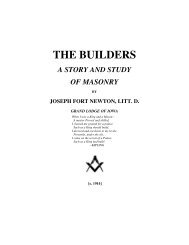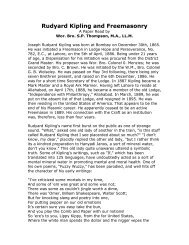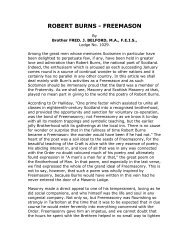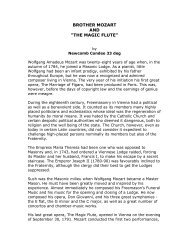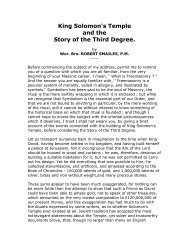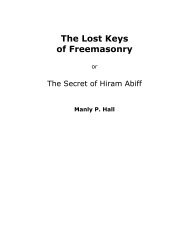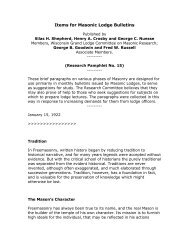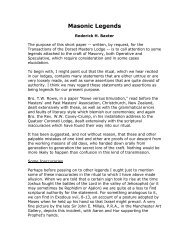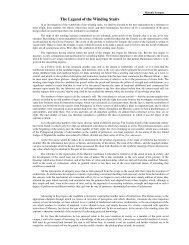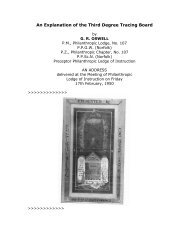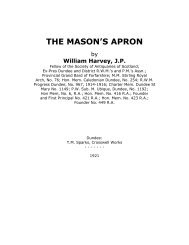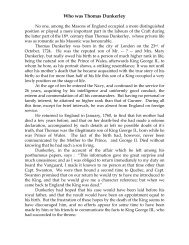Through the Key Hole - RoseCroix.org.au
Through the Key Hole - RoseCroix.org.au
Through the Key Hole - RoseCroix.org.au
You also want an ePaper? Increase the reach of your titles
YUMPU automatically turns print PDFs into web optimized ePapers that Google loves.
131<br />
LEWIS:<br />
The French word “Levees” meaning sprouts refers. In<br />
<strong>the</strong> old language spoken in England <strong>the</strong> letter “v” was pronounced<br />
like a “w” . Sprouts as a term meaning an off-shoot—a son?<br />
Possible!<br />
ABIFF:<br />
There is a French word “biffer” meaning to eliminate,<br />
thus Robinson asserts <strong>the</strong> name Hiram Abiff simply means “Hiram<br />
who was eliminated”. Most assiduous students of Freemasonry<br />
who have ventured into <strong>the</strong> realm of Hiram Abiff will jave agreed<br />
with <strong>the</strong> conclusion that “abiff” is in fact not a surname at all, certainly<br />
not as we know surnames, and was in fact a term of respect<br />
much in <strong>the</strong> way that “Sir” in English is used with a knight of <strong>the</strong><br />
land, so that Hiram Abiff meant basically Hiram <strong>the</strong> Master.<br />
In summary, I suggest that <strong>the</strong>se special words in Freemasonry<br />
are not so easily explained and that considerably more research<br />
needs to be undertaken before we can say with any degree of certainty<br />
what <strong>the</strong>ir meaning really is.<br />
45<br />
THE TAU CROSS<br />
By ANON<br />
In <strong>the</strong> 3º ritual <strong>the</strong> course followed by Hiram Abiff in his attempt to<br />
escape, forms a cross—a TAU cross. What is its significance?<br />
The TAU cross play an important part in Masonic ceremonies and<br />
is represented by <strong>the</strong> three crosses found on <strong>the</strong> apron of <strong>the</strong> Wor.<br />
Master of a lodge.<br />
It symbolises <strong>the</strong> creative power in God and man. As such it implies<br />
rulership and <strong>au</strong>thority and in <strong>the</strong> case of <strong>the</strong> Master it implies<br />
that inherent creative power within him of calling <strong>the</strong> lodge out of<br />
nothingness into existence.<br />
This is its nobler side, but <strong>the</strong> lesson to be drawn from its o<strong>the</strong>r<br />
interpretation is just as important. Here it stands for <strong>the</strong> animala<br />
passion in man which must be trampled underfoot if <strong>the</strong> Soul is to<br />
progress toward <strong>the</strong> light.<br />
The T<strong>au</strong> Cross is a cross in <strong>the</strong> form of <strong>the</strong> Greek T. It was among<br />
<strong>the</strong> ancients a hieroglyphic of eternal life. It was <strong>the</strong> form of a<br />
Nilometer, or measure of <strong>the</strong> Nile, used to ascertain <strong>the</strong> height of<br />
<strong>the</strong> inundation upon which <strong>the</strong> prosperity of <strong>the</strong> country and <strong>the</strong> life<br />
of <strong>the</strong> inhabitants depended.<br />
It was a favourite symbol of <strong>the</strong> Egyptians and was to be seen in<br />
all <strong>the</strong>ir Temples, very often held in <strong>the</strong> hands of <strong>the</strong>ir deities or<br />
suspended from <strong>the</strong>ir necks. In <strong>the</strong> initiation in <strong>the</strong> Hindustan Mysteries,<br />
<strong>the</strong> T<strong>au</strong> Cross was marked upon <strong>the</strong> body of <strong>the</strong> candidate<br />
as a sign that he was set apart for <strong>the</strong> sacred mysteries.<br />
The same mark was familiar to <strong>the</strong> ancient Hebrews for, in <strong>the</strong> vision<br />
of Ezekiel, it is alluded to “Go through <strong>the</strong> midst of <strong>the</strong> city and<br />
set a mark upon <strong>the</strong> foreheads of <strong>the</strong> men that sigh and that cry,<br />
for all <strong>the</strong> abominations that be done in <strong>the</strong> midst <strong>the</strong>reof.”<br />
This mark was to distinguish <strong>the</strong>m as persons to be saved on account<br />
of <strong>the</strong>ir sorrow for sin, from those who as idolators, were to<br />
be slain, and its form was that of <strong>the</strong> Hebrew letter T<strong>au</strong> which in



